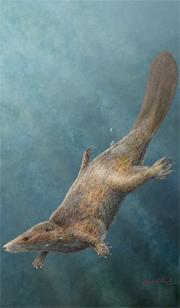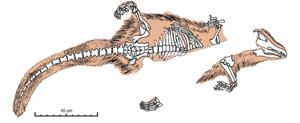 Bit like a beaver, bit like an otter: researchers have found the earliest-known aquatic mammal.© Science/Image courtesy of Mark A. Klinger/CMNH
Bit like a beaver, bit like an otter: researchers have found the earliest-known aquatic mammal.© Science/Image courtesy of Mark A. Klinger/CMNHAs a Jurassic predator, it was hardly in the big league. But compared with the shrew-like stature of the earliest mammals, it was a fearsome giant.
Meet the Jurassic 'beaver' from China. Living 164 million years ago, it's the oldest known furry member of the mammal family, and the first known to master swimming.
The specimen, described in Science this week1, was found by palaeontologists trawling the collections of the Jinzhou Museum of Palaeontology in China. Zhexi-Luo, of the Carnegie Museum of Natural History in Pittsburgh, Pennsylvania, and his team christened the creature Castorocauda lutrasimilis, meaning beaver-tailed and otter-like.
Like today's river otter, C. lutrasimilis probably lived in a burrow and hunted fish. And, a bit like a modern beaver, it sported a broad, flat, scaly tail.
At almost half a metre long, the animal is the biggest-known mammal-like creature of its time, and shows a hitherto unsuspected diversity in the shapes and sizes of the earliest mammals.
C. lutrasimilis would have been dwarfed by the giant reptiles that lived alongside it - but, says Luo, its burrowing lifestyle probably kept it safe.
Lifestyle choice
The discovery shows that early mammals and their relatives were experimenting with different lifestyles from the start, rather than waiting for the decline of the dinosaurs before diversifying.
 The fossil that made for the discovery.© Science/Image courtesy of Mark A. Klinger/CMNH
The fossil that made for the discovery.© Science/Image courtesy of Mark A. Klinger/CMNHMany of the early mammals were small and ate insects. But obviously not all of them. "A new picture is emerging, that at the earliest opportunity mammals started exploring new niches," says Luo.
It also shows that fur was crucial at the outset of mammals' evolution, Luo adds. "Fur is at the heart of our biology - it's important to keep us warm, and sweat glands [for keeping cool] are associated with hairs."
Early days
C. lutrasimilis was a close evolutionary cousin of the group that ultimately gave rise to all of today's mammals, explains Luo. But this branch of the mammalian family tree has since died out.
The evolutionary history of mammals is a long and complex one. The earliest mammals evolved from primitive terrestrial reptiles called therapsids, which lived some 200 million years ago. Since then they have diversified into the more than 5,000 species alive today.
ADVERTISEMENT
Over the years, several types of mammals have taken to the sea. C. lutrasimilis may have been the first, learning to swim and taking to the waters many tens of millions of years before the rise of the group that left the land entirely to become whales and dolphins.
Post a comment to this story by visiting our beaverswimsintovie.html">newsblog.
